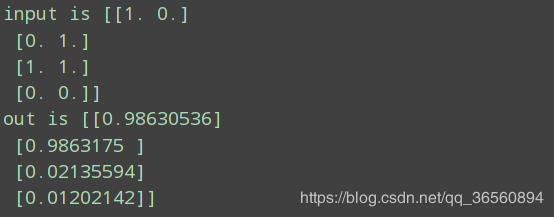PyTorch——解决异或问题XOR
试设计一个前馈神经网络来解决XOR问题
作者:我是大黄同学呀
该前馈神经网络具有两个隐藏神经元和一个输出神经元
github地址[https://github.com/Classmate-Huang/nnFramework/blob/master/EasyPytorch/XOR.py]
代码# 利用Pytorch解决XOR问题
import torch
import torch.nn as nn
import torch.nn.functional as F
import torch.optim as optim
import numpy as np
data = np.array([[1, 0, 1], [0, 1, 1],
[1, 1, 0], [0, 0, 0]], dtype='float32')
x = data[:, :2]
y = data[:, 2]
# 初始化权重变量
def weight_init_normal(m):
classname = m.__class__.__name__
if classname.find('Linear') != -1:
m.weight.data.normal_(0.0, 1.)
m.bias.data.fill_(0.)
class XOR(nn.Module):
def __init__(self):
super(XOR, self).__init__()
self.fc1 = nn.Linear(2, 2) # 一个隐藏层 2个神经元
self.fc2 = nn.Linear(2, 1) # 输出层 1个神经元
def forward(self, x):
h1 = F.sigmoid(self.fc1(x)) # 之前也尝试过用ReLU作为激活函数, 太容易死亡ReLU了.
h2 = F.sigmoid(self.fc2(h1))
return h2
net = XOR()
net.apply(weight_init_normal)
x = torch.Tensor(x.reshape(-1, 2))
y = torch.Tensor(y.reshape(-1, 1))
# 定义loss function
criterion = nn.BCELoss() # MSE
# 定义优化器
optimizer = optim.SGD(net.parameters(), lr=0.1, momentum=0.9) # SGD
# 训练
for epoch in range(1000):
optimizer.zero_grad() # 清零梯度缓存区
out = net(x)
loss = criterion(out, y)
print(loss)
loss.backward()
optimizer.step() # 更新
# 测试
test = net(x)
print("input is {}".format(x.detach().numpy()))
print('out is {}'.format(test.detach().numpy()))
效果

作者:我是大黄同学呀